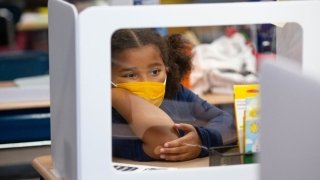The COVID-19 pandemic has unquestionably impacted student mental health. In addition to an alarming spike in emergency room visits among children due to anxiety, remote learning and social isolation cause higher levels of stress for kids and their families.
“It’s fundamentally unhealthy and unnatural for … young human beings who are so formatively growing to be disconnected from each other, from the adults who care about them, and from the communities that are raising them,” said Mary Helen Immordino-Yang, Professor of Education, Psychology and Neuroscience at USC Rossier. The comment came during “The School Safety Net in the COVID Age”, a web-hosted conversation that’s part of USC Rossier’s A New Vision for Schools project.
But while the pandemic has contributed to a decline in mental health among students, it didn’t create the problem. A report by California’s Mental Health Services Oversight and Accountability Commission (MHSOAC) cites an increase in student mental health needs over the past decade.
Schools are facing an emerging crisis that appears set to continue even after the pandemic subsides and students return to classrooms full time. Here’s what the experts from “The School Safety Net in the COVID Age” recommend schools can do to better address the mental health needs of students.
1. Devote school time to addressing stress
Dedicating a meaningful amount of time at school to addressing collective trauma is not only helpful for students, it can actually improve student outcomes.
Speaking during the "School Safety Net" webinar, Bror Saxberg, Vice President at the Chan Zuckerberg Initiative, noted that after the destruction to Houston, Texas caused by Hurricane Harvey, schools closed for four weeks. Upon re-opening, many districts felt pressured to catch up on curriculum. However, the Nottingham district spent two weeks addressing the enormous stress experienced by students, teachers and staff. And despite a six-week deficit in curriculum, the district actually improved their test scores over the prior year.
“You really do have to take care of kids’ and teachers’ well-being in order to unlock academic progress and success,” noted Saxberg.
2. Expand mental health resources
According to a report by the California state auditor, over 1,000 school districts and county offices of education in California say they lack adequate mental health professionals on staff.
“It’s not enough to have a mental health counselor and their contact information … There needs to be a mindset where everyone can have a discussion about mental health,” said José Muñoz, Director of the Coalition for Community Schools.
This could take the form of mental health wellness centers, a proposed solution in California where K–12 schools work with nonprofits and government health agencies to help students and families navigate trauma and other challenges. But perhaps more importantly, school districts should prioritize student mental health at every level, and openly address it with students.
3. Determine what’s relevant to students
One way to de-stress learning and increase student engagement is to keep school work relevant. Relevance can include practical, real-world problems and solutions, but it has deeper, personal implications as well.
“Relevance is an emotional feeling,” said Immordino-Yang. It triggers a cognitive response in individuals to class curriculum that makes them feel enthusiastic and empowered. Immordino-Yang expands on this idea and offers examples in her article, Building Meaning Builds Teen’s Brains.
4. Develop student data
Data can be a useful tool for school districts that want to address student mental health. During remote learning, some schools have begun using attendance and enrollment metrics to identify which students are missing class, and may need additional support.
Additionally, qualitative data can be useful as well. “Every time [teachers] turn on a virtual screen, it's a home visit,” said Muñoz. In addition to academics, engaging students on what’s happening in their at-home environment can provide insight on the individual, and help construct a narrative about the state of student well-being more broadly.
5. Prioritize one-on-one conversations with students
With fewer in-person interactions, it’s harder for teachers to identify signs of anxiety in students. It’s useful then for teachers to be intentional about having more one-on-one virtual conversations.
Saxberg helped develop Along, a tool for teachers designed to build more robust relationships with students. According to Along’s website, it provides research-based prompts to help individuals or entire classes address mental health-related topics such as staying motivated, managing stress, and setting goals.




